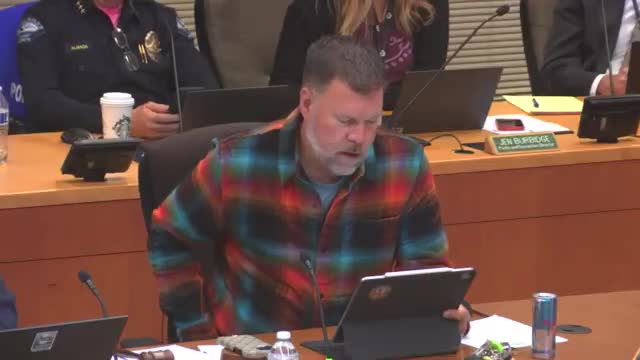City staff recommend continuing 4.5% stormwater rate increase for 2026; consultant study to follow
October 29, 2025 | Lacey, Thurston County, Washington
This article was created by AI summarizing key points discussed. AI makes mistakes, so for full details and context, please refer to the video of the full meeting. Please report any errors so we can fix them. Report an error »

City stormwater and finance staff told the council they recommend a 4.5% stormwater rate increase for 2026 to address rising operating and capital costs tied to new regulatory requirements and aging infrastructure.
Troy (Stormwater/Finance) described the recommendation as a continuation of an existing, multi‑year approach. Staff said prior rate planning stemmed from a stormwater comprehensive plan covering 2020–2025; a refreshed financial chapter and rate study are expected early in 2025. Until that study is complete, staff recommended a 4.5% increase for 2026 to maintain predictable revenues and fund immediate needs, including a backlog of stormwater pond rehabilitations and longer‑term permit obligations.
Staff emphasized permit‑driven workload increases in the current National Pollutant Discharge Elimination System (NPDES) permit cycle (2024–2029), including expanded mapping, additional street‑sweeping and runoff requirements; staff noted the new permit adds obligations rather than reducing them. Short‑term staffing increases and long‑lead capital needs (pumps, valves) were presented as cost drivers.
The presentation included a historical comparison between previous comp‑plan‑projected revenues and actual receipts; staff said cumulative stormwater revenues through 2024 exceeded the earlier comp‑plan forecast but that expenditures in 2024 also ran higher than the earlier plan, and that 2026 capital needs are expected to increase the program’s spending. Staff said continuing a steady 4.5% increase is intended to avoid future “rate shock” and to preserve the utility’s ability to meet permit and capital obligations. A detailed rate study and updated financial plan will follow early next year and will be used to set rates beyond 2026.
Council questions addressed whether stormwater work supports climate and tree‑canopy goals; staff said stormwater mapping and canopy work is complementary to urban forestry efforts and that updated canopy mapping is expected during the coming permit period.
Ending: Staff will present the rate proposal in the formal revenue‑setting process and expects to return with a consultant‑led rate study early next year to recommend longer‑term rates and scenarios.
Troy (Stormwater/Finance) described the recommendation as a continuation of an existing, multi‑year approach. Staff said prior rate planning stemmed from a stormwater comprehensive plan covering 2020–2025; a refreshed financial chapter and rate study are expected early in 2025. Until that study is complete, staff recommended a 4.5% increase for 2026 to maintain predictable revenues and fund immediate needs, including a backlog of stormwater pond rehabilitations and longer‑term permit obligations.
Staff emphasized permit‑driven workload increases in the current National Pollutant Discharge Elimination System (NPDES) permit cycle (2024–2029), including expanded mapping, additional street‑sweeping and runoff requirements; staff noted the new permit adds obligations rather than reducing them. Short‑term staffing increases and long‑lead capital needs (pumps, valves) were presented as cost drivers.
The presentation included a historical comparison between previous comp‑plan‑projected revenues and actual receipts; staff said cumulative stormwater revenues through 2024 exceeded the earlier comp‑plan forecast but that expenditures in 2024 also ran higher than the earlier plan, and that 2026 capital needs are expected to increase the program’s spending. Staff said continuing a steady 4.5% increase is intended to avoid future “rate shock” and to preserve the utility’s ability to meet permit and capital obligations. A detailed rate study and updated financial plan will follow early next year and will be used to set rates beyond 2026.
Council questions addressed whether stormwater work supports climate and tree‑canopy goals; staff said stormwater mapping and canopy work is complementary to urban forestry efforts and that updated canopy mapping is expected during the coming permit period.
Ending: Staff will present the rate proposal in the formal revenue‑setting process and expects to return with a consultant‑led rate study early next year to recommend longer‑term rates and scenarios.
Don't Miss a Word: See the Full Meeting!
Go beyond summaries. Unlock every video, transcript, and key insight with a Founder Membership.
✓
Get instant access to full meeting videos
✓
Search and clip any phrase from complete transcripts
✓
Receive AI-powered summaries & custom alerts
✓
Enjoy lifetime, unrestricted access to government data
30-day money-back guarantee

